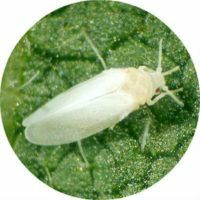
How do pests get to the indoor flower? There are many reasons, and the main one is a violation of the rules for caring for the plant, leading to its weakening and diseases. Then airing the room, transplanting the flower into infected soil, introducing insects on the outer clothing - these and other factors will prove fatal for the pet. The insidious enemies must be known "in person" in order to fight them more effectively.
- Whitefly
- Track
- weevils
- Grape snout beetle
- Drosophila
- Pliers
- cyclamen
- Spider
- root
- Woodlice
- Centipede
- Fly stsiarida( fungus gnats)
- Nematodes
- Root
- Stem
- Sheet
- sublevels( springtails, vilohvostki)
- Slugs
- Aphids
- Root worm
- Powdery mulberry( shaggy aphid)
- Shield and groove
- Thrips
- Earworm
- Worms
- EnItera
Whitefly
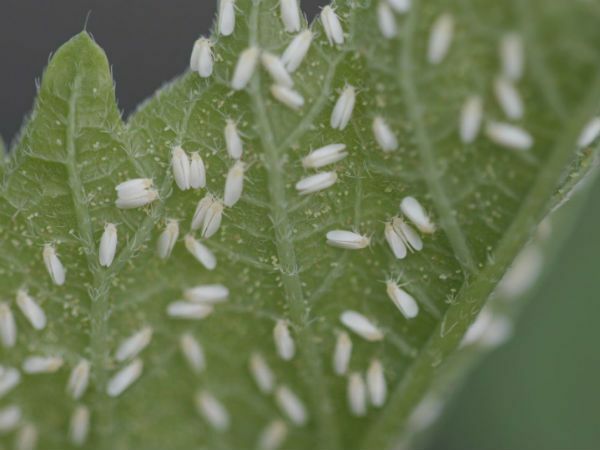
White pests like to settle on these houseplants as pelargonium, hibiscus, begonias. The favorite habitat of these, resembling tiny moths, white and yellow insects, with two pairs of pollen-covered wings - the reverse side of the leaves. The eggs of these parasites on the leaves look like grayish grains of dust.
Rapidly multiplying, they and their oval, oblong, light-green larvae suck the juice out of the leaves, leaving behind their memory sweetish traces. And they have a black fungus. In addition, these harmful "moths" often suffer from viral diseases.
It is difficult to fight these insects. To reduce their number help Velcro fastened next to the flowers, washing their eggs and larvae. From these pests indoor plants effective treatment with infusion of garlic:
- a pair of teeth to withstand a liter of water for several days;
- dilute five times;
- reapplied after a week.
Irrigating with Nicotine-sulfate or Paraton and insecticide crayons from pest of indoor plants( "Brownie Prosshka", "Nika").
to the table of contents ^Caterpillars
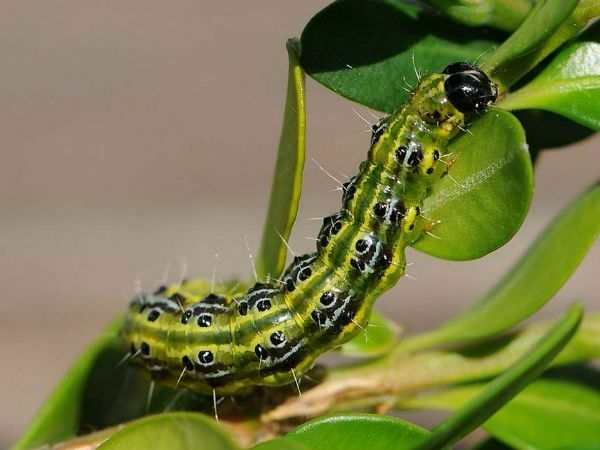
These lovers will regale themselves with young branches, leaves and buds, they are more familiar as enemies of garden plants. They do not disdain the room flowers placed in the summer garden. Insects work mostly at night, and during the day they hide under the leaves.
The main measure to combat them is manual collection. And the prevention of their spread is spraying with specific biological preparations - "Lepidocide" and "Bitoxybacillin".They do not harm a person and animals, and when they get into the intestines of these insects, they are killed.
Some gardeners use anti-caterpillar spraying plants with a two-fold "Coca-Cola", which causes poisoning. An effective home remedy for these pests of houseplants is a household or green soap. Its weak aqueous solution also alkalizes the acid soils.
to the table of contents ^Weevils
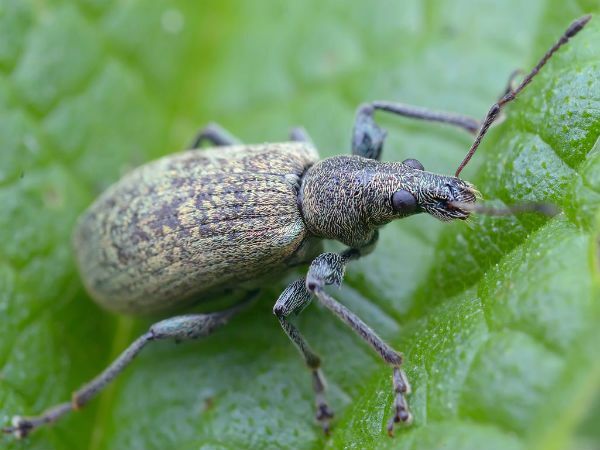
Small flying bugs like to gnaw leaves, like Colorado beetles. And their larvae destroy the roots and tubers of plants. Beetles should be collected early in the morning.
They and their larvae are helped by spraying with systemic insecticides such as "Fufan", "Inta-vir".Alternative method - four-time soil watering with "Aktary" solution( per gram per bucket with a weekly interval) or a single foliar treatment with this drug with a dose increased by 8 times.
An effective measure of control of larvae is the transplantation of plants into fresh soil. Before it should be decontaminated the roots of damaged plants with a weak solution of potassium permanganate for half an hour.
to contents ^Grape Scissor
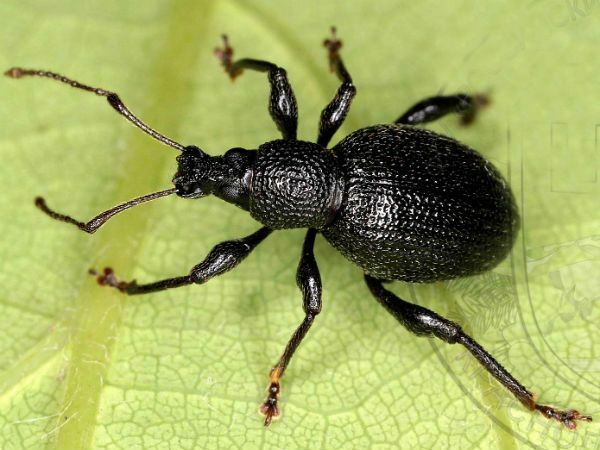
Small bugs, representatives of a large family of weevil beetles. They eat the leaves of flowers that are exposed to nature in the summer. Their two centimeter larvae gnaw the underground parts of plants. The presence of these soil pests of indoor plants is found only when the plants wither, and their roots are already significantly damaged during this period.
Beetles with primrose or cyclamen should be removed by shaking on film or paper. Do it better cool in the early morning, when the "flyers" are not yet awake and inactive. With massive accumulations of beetles, the best method of combating them is spraying with 10% Carbophos.
Drosophila
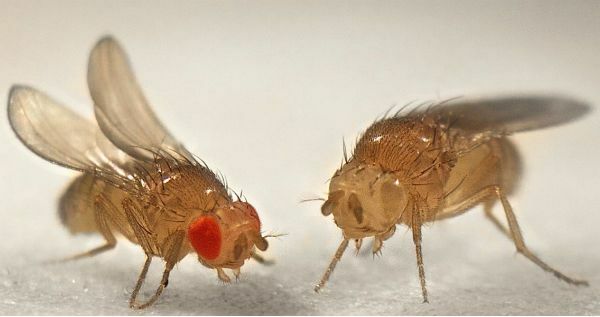
For indoor plants, they are peculiar, since the tiny dark flies attract the smell of rotting products. They are dangerous with the ability to spread small pests and infections on themselves.
They appear in flower pots, where the soil is moist and the rotting of roots or fallen leaves has already begun. It is also possible to transfer these flies through the garden soil contaminated with eggs.
Therefore, in order to avoid getting into the fruit flies of Drosophila, it is necessary to transplant the plants only to the decontaminated soil or to the ready nutrient substrates purchased in specialized stores. Watering plants should be moderate, and the faded flowers and missing leaves should be removed.
to contents ^Pliers
Numerous types of ticks are especially active in the spring. Quickly multiplying, these inconspicuous pests gnaw the stems of plants, leading them to death. The most common subspecies of pests:
to contents ^Cyclamenum
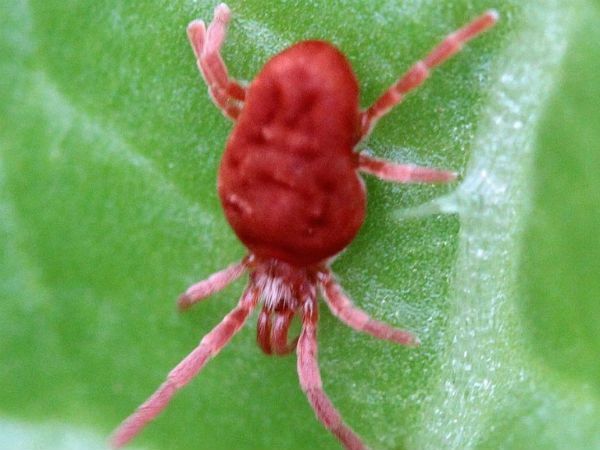
This is a monophage, attacking only cyclamen, pelargonium and gloxinium. Its colonies are similar to dust raids on the reverse side of the leaves. It is a rare kind of mite living in dampness. The result of his presence is the weakening of plants: they do not grow, the blossoming flowers do not fall, the leaves are twisted and the stems become thinner.
to contents ^Spider-like
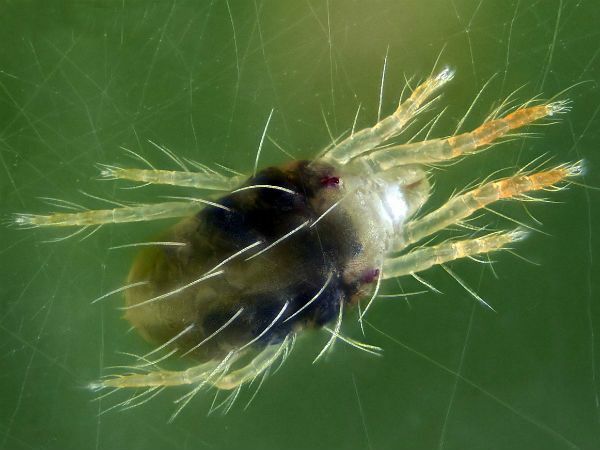
A comfortable condition for this hard-to-parasite parasite is dry and warm air. It operates year-round on many types of plants. On the specimens affected by them, small dark spots appear on the leaves. And then they become gray from the entangling cobweb over which microscopic reddish dots, mites, scurry.
Root
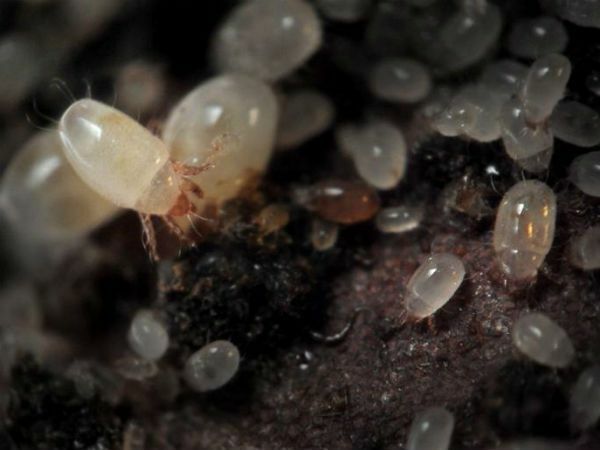
This species of ticks specializes in bulbous plants. Oval, millimeter, yellowish eight-legged parasites, gnawing flower bulbs, lay hundreds of eggs there. Gradually, only the husk remains from the bulb. These pests are resistant to temperature changes. And under adverse conditions they do not perish, but fall into hibernation until better times.
Preventive measures against mites:
- Most of them do not tolerate high humidity, so you need to periodically spray plants with standing warm water.
- Due to the fact that the spider's mites are afraid of ultraviolet irradiation, it is necessary to spend two minutes of treatment of plants( especially under leaves) in the winter, with special lamps, and in the summer - to take them out to the balcony. This also increases the immunity of pets.
- When storing the bulbs, it is necessary to maintain a constant coolness and medium humidity in the room.
- Pot plants need good drainage of the soil, and excess moisture from the pallet should be removed.
Treatment with folk remedies:
- Spraying and dusting with sulfur powder.
- Spraying infusions of red pepper, tobacco, garlic, celandine. But sometimes they act only temporarily.
- Spraying or wiping leaves with medical alcohol. This method is suitable only for flowers with dense leaves( palms, ficuses, roses), and for cacti or succulents it is used only in a limited way.
- The most effective ways to combat mites are the use of "Fitoverm", "Aktelik", "Neoron", "Apollo".Since these pests adapt well to chemical agents, they must be alternated.
Moistice
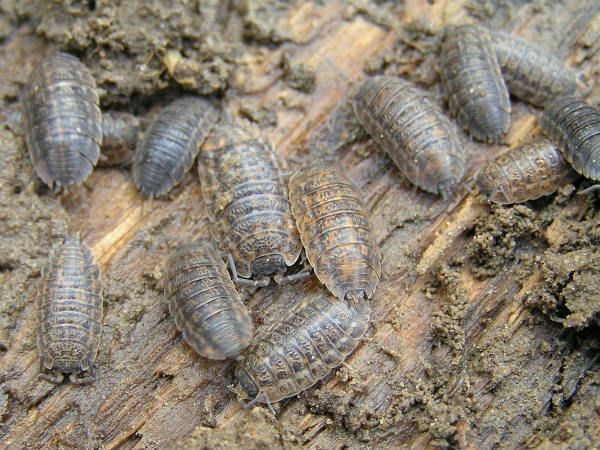
These are small crustaceans, outwardly similar to mealybugs. They also have a gray-brown shell. These insects sometimes reach a value of up to several centimeters. They can be found in pots with loose and nutritious ground, where they move quickly with 8 pairs of legs.
These are the worst enemies of tropical plants( orchids, ferns, cacti), in which they damage the tender roots. In addition, pests press the soil, which leads to disruption of nutrition and respiration of the roots.
They get to the potted plants that spend summer in the garden. Detect uninvited guests can be a bunch of dry earth substrate, constantly pouring out of pots in a pallet.
Treatment of indoor plants from these pests is reduced to their transplantation into a new earth mixture with preliminary washing of the roots with warm water. You can also omit such plants for a couple of tens of minutes in a container of warm water. And the insects that come up with it are very easy to assemble.
Centipedes
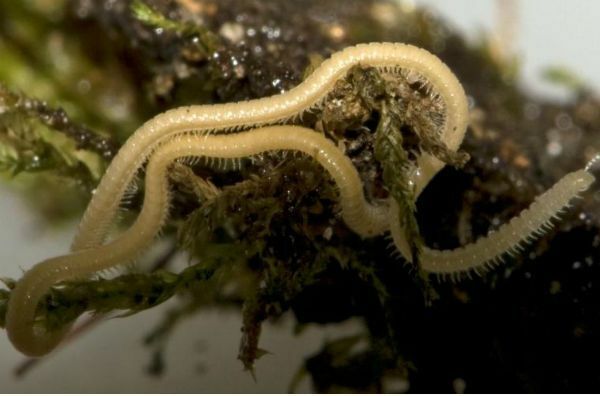
These caterpillars, which are reminiscent of the caterpillar, are quite noticeable in flowerpots, toogarden. Their favorite food is the lower parts of plants. The main preventative against these pests of indoor plants is the prevention of dampness in the ground.
The earth in a flowerpot is dried with sand or ash. Parasites are also effective from parasites. The meaning of them is that next to the plant put some opaque and flat object, under which pests will hide. Lifting the trap, you can remove these pests and remove them.
to the table of contents ^Fly of the sciarid( mushroom mosquito)
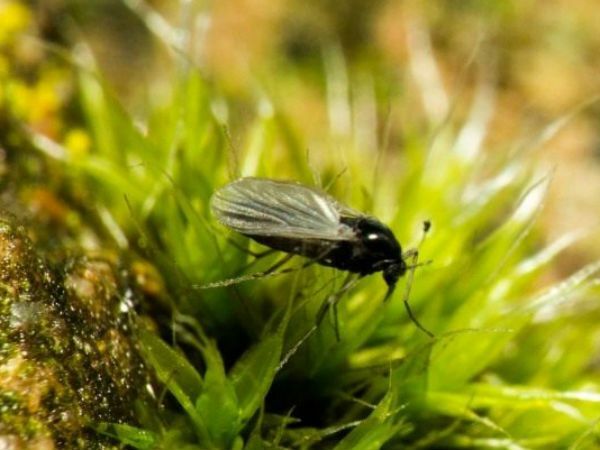
These flying pests of houseplants reach a size of up to 0.5 centimeters. Adult mosquitoes lay in the roots of flowers tiny eggs. The larvae emerging from them, eat up roots, why pets often die.
Adult individuals often infect flowers and spread larvae of different pests. They settle in pots, hitting the street during the ventilation of the room or in another way. They reproduce well in a humid and nutritious environment, especially rich in humus. Often present in aquarium water.
Larvae of insects are removed with the help of preparations "Decis", "Carbophos", "Inta-vir".And one-time treatment is often ineffective. From adult pests, help from flies: special Velcro, Raptor, Fumitox, and if they are ineffective, then Dichlophos. As a rule, complex measures are used repeatedly.
to contents ^Nematodes
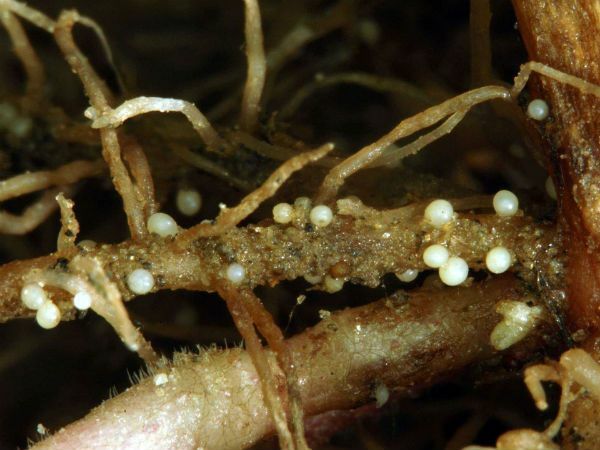
These are 3 groups of white round small worms that live in different parts of tropical flowers:
to contents ^Root
Parasites are attached to the roots, destroying them, they can live there for many years in anticipation of suitable conditions. Plants wither, they do not grow, flowers melt, branches are deformed.
to table of contents ^Steplike
Live at the base of the stem, causing death of plants due to lack of nutrition.
to contents ^Sheet
Millimeter earthworms. When they appear on the leaves, greenish, rapidly darkening specks are observed. Kidney plants do not develop, young shoots, the tips of the stems and buds dry up. These individuals are distributed with contaminated water.
To prevent the ingestion of these almost undetectable pests, disinfect the earth at a temperature above 50 degrees 10 minutes or treat it with 10% formalin, washing it off after only a couple of hours. Garden tools and containers for flowers are also disinfected.
There are no effective measures against these dangerous pests. Weakly affected plants are treated with means of "Decaris"( the tablet dissolves in a liter of liquid) or "Heterophos".Launched flowers and earth from them destroy.
to the table of contents ^Furfish( spring-tailed tulips, spiked fork)
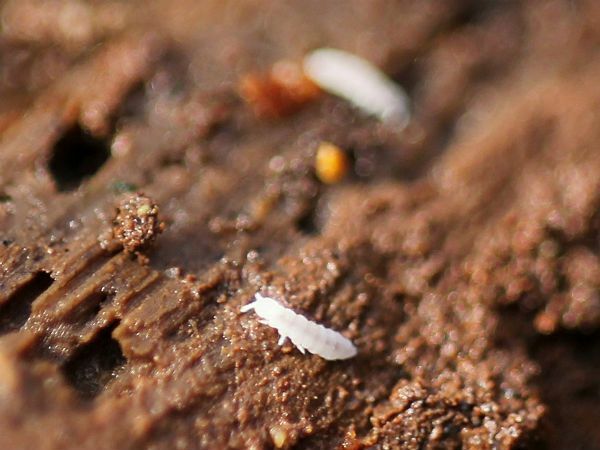
The appearance of these millimetric wingless pests usually indicate excessive moisture of indoor plants. They live in the soil, eating small roots of flowers. If there are a lot of them, you can notice colonies of insects on the bottom hole of the pot or on the ground. They look like whitish particles.
They do not cause any particular damage to the plants; rather, they even bring benefit to attentive growers, signaling by their appearance that it is necessary to reduce the watering of plants in order to avoid decaying the roots. The soil in places of accumulation of insects is replaced, sprinkled with sand or shredded tobacco.
to the table of contents ^Slugs
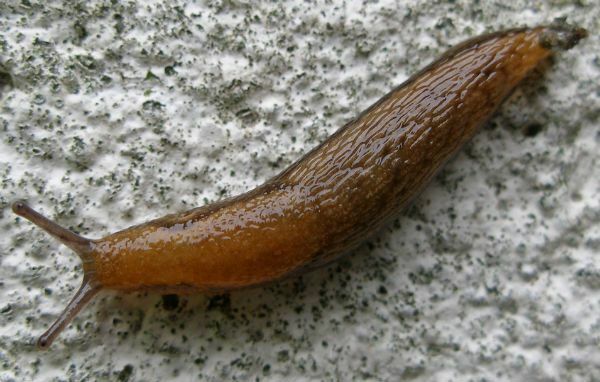
These pests affect balcony plants - irises, phloxes, carnations and others. If there are sores on the leaves and petals of flowers, then this is the work of slugs. Visually, insects can also be seen, especially with dampness.
Get rid of slugs by drying the soil with ash and lime( 4: 1).In addition, the combined plants are sprinkled with powdered tobacco and lime( 1: 1).Do this 3 times a day every 2 hours. And, of course, it is necessary to reduce watering of plants in order to avoid the reappearance of these hygrophilous pests.
to contents ^Aphids for
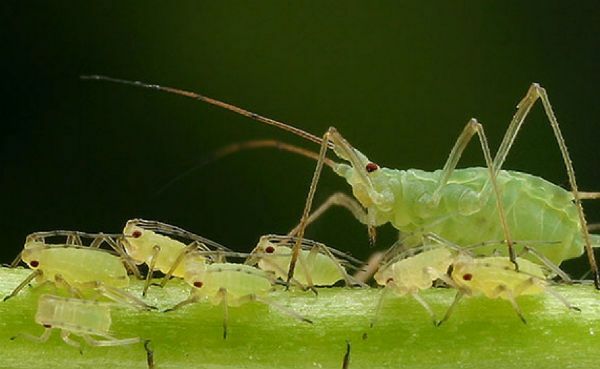
These are representatives of a large detachment of parasitic small insects( winged or wingless) that feed on plant juice. They are rapidly multiplying, occupying all large arrays. Winged species of insects, easily getting into the room in various ways, also spread infections, especially fungal.
Coloring is different, they live in large colonies on the most juicy parts of plants. If you do not take them, the plants under the pressure of significant enemy forces are weakened and perish. Fortunately, coping with them is not difficult. Common pests are:
to contents ^Root worm
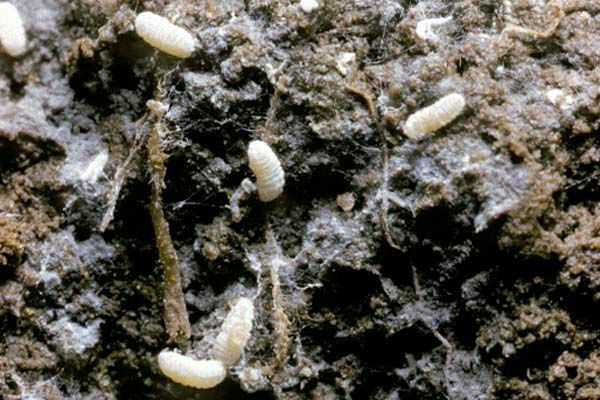
White aphid, which settles on the roots and lower part of the stems as a whitish plaque. In this case, the flowers do not grow, the leaves turn pale, fade, wrinkle. Weakened plants often suffer from fungal diseases. Most often these parasites attack wintering plants with minimal watering.
In the spring and autumn, they should be watered three times with insecticides with a break in a couple of weeks. Affected plants prune the damaged fragments( and partially the crown), washing the roots for ten minutes with an insecticide. Then they are transplanted to a new land.
to contents ^Powdery mulberry( shaggy aphid)
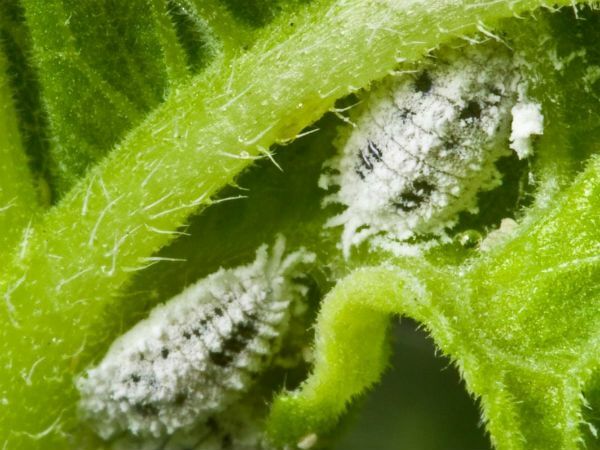
Lives on leaves and stems. It is considered the most dangerous pest. Winged insect, his female planted up to 2 thousand eggs, which is not afraid of water. The presence of a pest signifies a white cobweb-like plaque on plants. A secretion of aphid sticky substance - a favorite habitat of black fungus. Flying insects do not disdain any plants, leading them to death.
to table of contents ^Shielding and falsetting
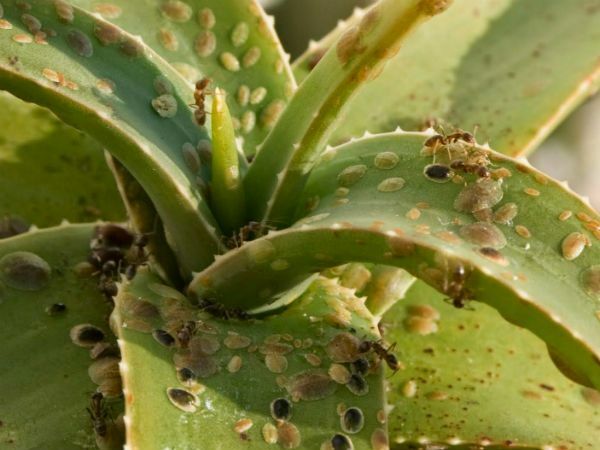
Shield aphids( scabbards) are a half-centimeter brown insect that appears on the leaves in the form of scales. Waxy shell protects it reliably from many chemicals. Males in insects flying. Dummies are not equipped with such a shell. Their larvae and eggs are protected by the dried skin of females. Among them there are viviparous varieties. Both of them live on the leaves and stems of plants.
Adult individuals do not move much, look like a raid on plants. Because of them, green pets are weakened, the leaves turn yellow and disappear. And on the insoluble sticky insect the sooty fungus is formed. These pests are dangerous for many types of potted flowers. To prevent the harmful effects of these parasites, it is necessary to periodically inspect the plants and remove their affected parts.
Preventive measures are reduced to monitoring the purity of flowers, washing the leaves. You can also use sticks against pests of indoor plants( Agricola, Pure Leaf, Sparkling Golden), which are also a fertilizer for flowers.
Control of harmful insects:
- Three-time spraying with solutions of green soap, tobacco, garlic.
- Leaf washing with alcohol, vinegar or a chemist's preparation of calendula.
- Two-time( in a week) spraying with "Aktelikom", "Fitoverm", "Vertimecom" or others.
Thripsy
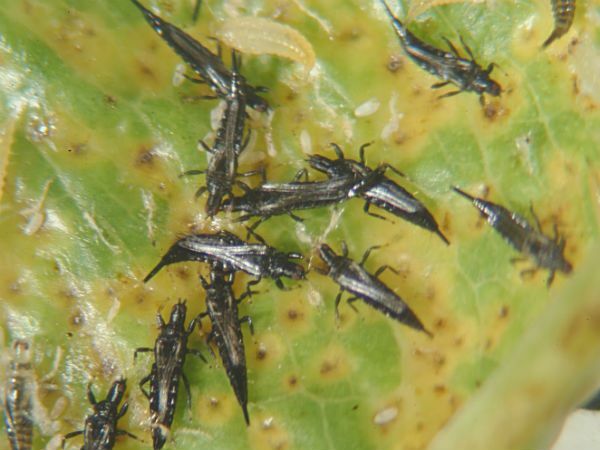
This is a dark, barely noticeable four-winged insect. Their larvae almost immediately become winged, but lighter than adults. There are a lot of them on the lower part of the leaves, where they leave the whitish substance. Then the leaves become brown, dry and disappear. The same happens with flowers.
Especially dangerous thrips in the summer heat, causing damage to palm trees, cacti, roses and many more common houseplants. Therefore, for prevention, they should be sprayed with water, not allowing the drying of the earth.
Good help from these pests on indoor plants powder-insecticide "Bushido"( half-packs diluted in 5 liters of water).Effective are also such remedies:
- Twice( in a week) treated with feverfew( 2 grams per liter).
- Infusions of yarrow, tobacco, chamomile, green soap, broth cyclamen tubers.
- Pollution with powdered pyrethrum, spraying( three times) with 0.2% "Thiophos", "Vertimec" or "Phosphamide".
Earworm( mitesweeper)

This is a widespread pest of garden plants. She is awake at night, hitting leaves and flowers until they are destroyed.
Onion peel( 6 grams per liter), infused half a day, helps to get rid of these pests of indoor plants.
Traps are also effective from thin tubes of thick paper or hollow wooden sticks placed on flowerpots. Night pest in the morning hides in them, and it is easy to detect and remove from flowers.
to contents ^Worms of rain
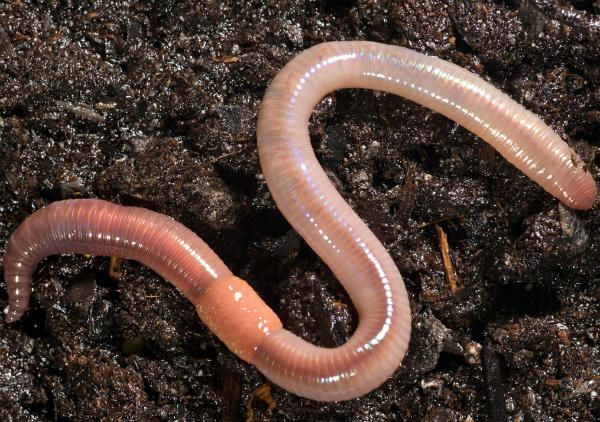
Familiar to all earth inhabitants, creeping out of the soil after the rains. Having fallen from the garden land into a tight pot where organic feeding is not enough, they do not disdain the roots of plants. May also appear from the eggs left in the soil brought from the street. In the vicinity of worms, pets disappear and grow poorly.
The street ground should be disinfected before planting. And taking home plants in the summer garden, it is better to put them so that they do not touch the ground. Get rid of worms can be as follows:
- Put the flower pot for half an hour in warm water, then the worms either appear from above or drown.
- Drizzle plants with a weak solution of potassium permanganate and collect the pests that have emerged outside.
Enchiterei
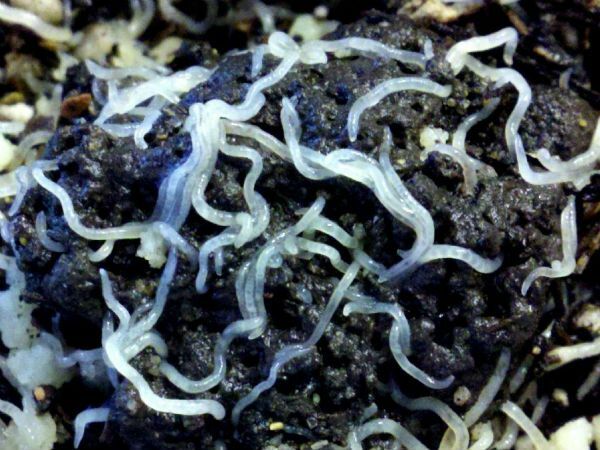
These are small light worms living in the roots of plants. From their activity, plants die. The reason for the appearance of worms is the overmoistening of the soil. To get rid of parasites, you need to thoroughly wash the roots, removing all the earth from them. Then transplant the plant into another soil. Helping them also watering flowers with insecticides.
